
Porsche’s unsung heroes 924 meets 944 and 968. Porsches for the people: the frontengined bargains. Who needs a flat-six? We drive the brilliant 924, 944 and 968 ‘fours’ that saved Porsche.
BACK TO FRONT
Porsche’s four-cylinder family of 924, 944 and 968 played a vital role in the firm’s survival, says Malcolm Thorne, and now offers great value for money. Photography Tony Baker/Porsche/LAT.
Way back in 1516, the Bavarians adopted a statute – the Reinheitsgebot – that sought to control the ingredients of beer. Five centuries on, the law may have evolved, but Germany still proudly regulates its brewing industry. Add anything unexpected and you can’t call it bier. Much to the chagrin of 911 fans, such purity orders have never applied to Porsche. As a result, 41 years ago the marque released one of the most controversial models in its history – the 924.
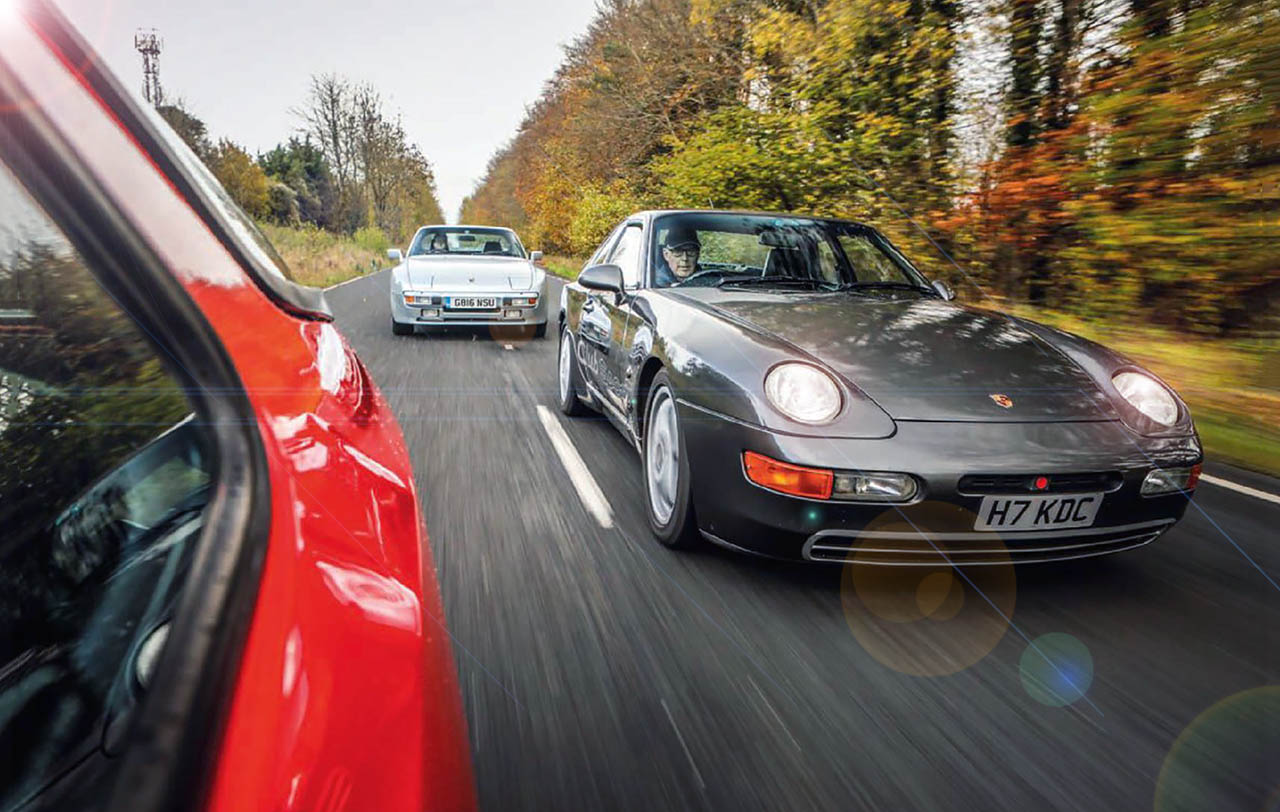
The 968’s styling gave it a family resemblance to the 928, thanks to the exposed pop-up lights and revised nose section. Below left: the 924 handles brilliantly, with well-weighted steering.
The car was totally at odds with the company ethos, yet it deserves to be honoured. A worthy enough design in isolation, it went on to spawn two of the most capable sports cars of the 1980s and ’90s – the 944 and 968. Unveiled in 1975, the 924 represented a new direction for Stuttgart. For the first time, Porsche had deviated from its stock-in-trade of air-cooled horizontally opposed engines mounted behind the driver. As if that wasn’t enough, up until a few months before its launch the intention had been for it to wear the VW roundel.
Its origins can be traced back to the early 1970s, when Volkswagen turned its attention to replacing the VW-Porsche 914. Development of the new model, codenamed Entwicklungsauftrag 425, was subcontracted to Porsche’s Weissach R&D department, the brief calling for a sporting coupé that, to contain production and development costs, would draw the maximum number of components from the VAG parts bin.
Early mules were constructed using a wellworn BMW 1600 and then an Opel Manta as a basis, but EA-425 would emerge as a slippery 2+2 fastback that was styled in-house by Dutchman Harm Lagaay. The 924 represents a defining moment in his career: “I was a selftaught 27 year old, and this was my first complete car. We took a number of proposals to Wolfsburg, and Rudolf Leiding chose mine. It was a very exciting moment, but daunting, too.
“People often ask me how much I was influenced by the Ferrari Daytona, because some early sketches did resemble it. I’d always been a fan of Italian cars, but back then the Daytona wasn’t held in the same regard as it is today. It was just one influence among many. It would have been nice to push the design further, but Volkswagen was happy with it as it was. If the client likes it, you don’t change it.”
Power came from a fuel-injected 1984cc engine that would also find a home in the Audi 100 and AMC Gremlin, plus – horror of horrors – the Volkswagen LT van. Truth be told, though, the Porsche unit was far from identical to that used in other, lesser applications.
The running gear was from Volkswagen, while the four-speed gearbox was pinched from Audi. In a bid to optimise weight distribution and avoid the expense of developing a bespoke transmission for a front-engined, rear-wheeldrive layout (VW didn’t have a suitable unit in its arsenal at the time), the usually front-drive gearbox was placed at the rear. Curiously, this left an empty bellhousing beneath the tail, EA-425’s clutch being mounted at the front and separated from the transmission by a 2m propshaft.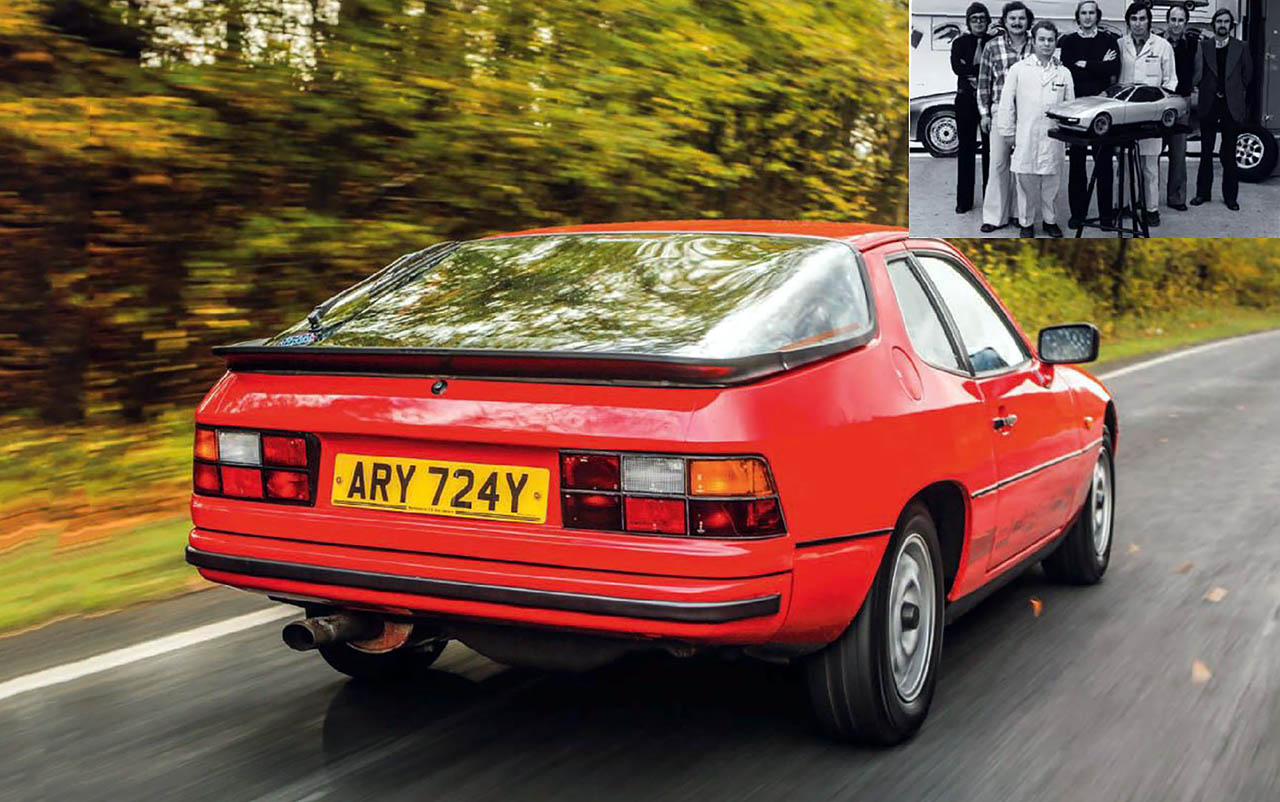
The 924’s clean styling is ageing well. Above: Harm Lagaay (centre) pictured in 1973, with the design team and an early model.
The story took an 11th-hour twist during the winter of 1974-’75, when Toni Schmücker replaced Leiding as head of Volkswagen. The mid-’70s oil crisis and the ensuing recession had seriously knocked VW’s finances. Schmücker had more pressing concerns than EA-425, especially since the new Scirocco already provided him with a coupé in Wolfsburg’s line-up. On the other hand, with 911 sales plunging, Stuttgart desperately needed a new moneyearner.
To both parties, there was a rational argument in favour of Porsche taking over EA-425. When the proposition was put to Schmücker, he was more than happy to oblige. As part of the deal, VAG would supply componentry at a favourable price, while production would be subcontracted to Audi, thus saving its Neckarsulm factory. Rather than purchasing the rights to EA-425 outright, Porsche would pay a royalty to VW on each of the first 100,000 cars produced. As a bonus, EA-425 also tied in neatly with Stuttgart’s plans to pension off the 911 in favour of the front-engined, water-cooled 928, work on which was already well under way.
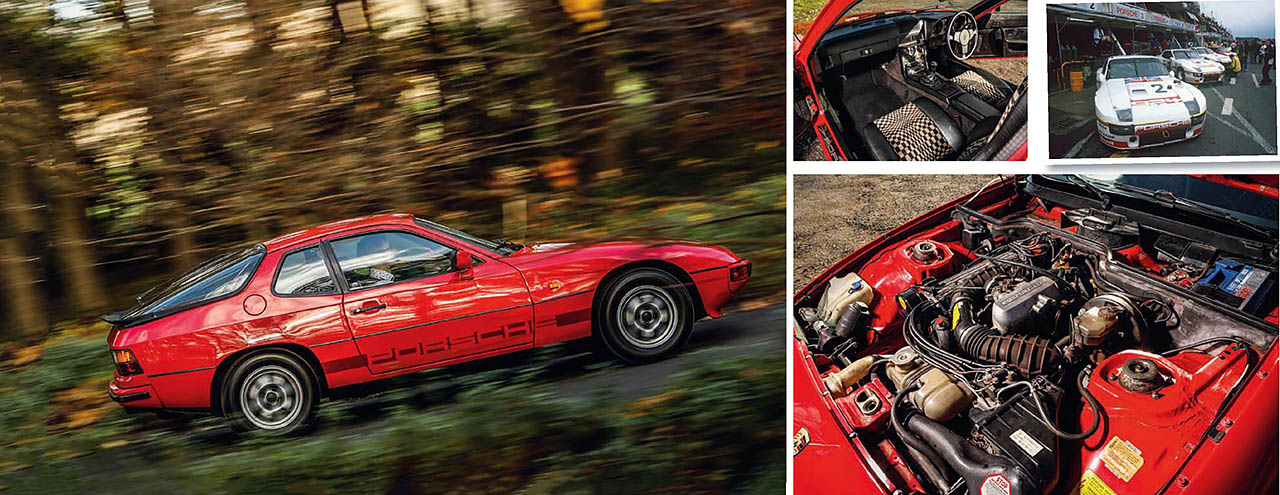
Straightline performance is best described as brisk rather than quick. Below: well-built cabin with deeply dished gauges and signature Pascha trim; the 2-litre ‘four’ was canted well over in the engine bay.
“The changes we made to turn it into the 924 were minimal,” remembers Lagaay. “A bit more than just swapping the badge, but not by much. I think it still looks good today, though.”
The deal was signed in February 1975, and nine months later EA-425 broke cover as a Porsche, the first cars reaching buyers in 1976. Had it been badged as a VW – and priced accordingly – it would surely have received the highest praise because it’s well sorted, with sharp looks, fine road manners and an impressive level of comfort. But it’s not a VW, and it certainly wasn’t priced like one. Road-testers praised the handling and top speed, but were unimpressed by the lack of refinement in a car that cost 50% more than an Alfa GTV.
It was an inauspicious start, but for its manufacturer the 924 was very much the right car at the right time. As Michael Cotton, Porsche GB’s former public relations officer, remembers: “911 owners gave it a cold reception, but dealers loved it because it gave them something else to sell. People would say to me that they’d always wanted a Porsche, and that now they could afford one. It opened up a whole new market.” A 140mph turbo joined the line-up in 1979, offering vastly improved performance, but the nay-sayers were still quick to denounce its humble DNA. Time, then, to move up a gear. Unveiled at the Frankfurt Motor Show in 1981, the 944 was a muscular, wide-bodied evolution of the 924, its flared arches aping the Carrera GT racers.
There was, however, much more to the revised car than a mere aesthetic reinterpretation. A host of subtle but useful chassis modifications included a wheelbase that had been stretched by 1.8in, plus the adoption of disc brakes at the rear, but the real change lay beneath the bonnet – a bespoke motor finally bestowing the 944 with the credibility that, for some, the 924 had always struggled to attain.
Various options had been considered during development, including a six-cylinder unit. At one stage, the PRV Douvrin V6 had been shoehorned into a mule for trials, but – against a backdrop of increasing oil prices – a lighter, more efficient all-alloy ‘four’ was favoured. To facilitate manufacturing and reduce costs, the new oversquare lump was modelled around the 928’s V8 (with which it shared a number of key dimensions). The result was a 30% increase in power as well as almost 25% more torque, plus massively improved refinement.
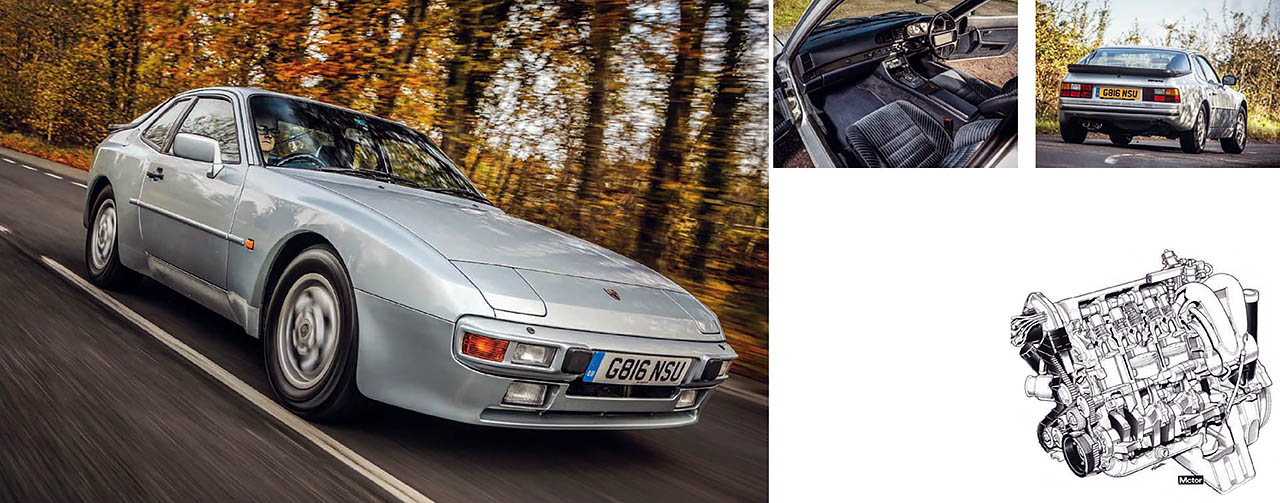
Clockwise, from main: the wider-body 944 features an altogether more aggressive stance than the 924; secure handling; revised dash and pinstripe seat trim.
The secret behind such finesse was the use of counter-rotating balancer shafts. This exoticsounding fix is actually little more than a pair of carefully positioned belt-driven eccentric bob weights attached to either side of the block and spinning at twice engine speed. For a cost of just 3-4bhp (plus a royalty to Mitsubishi, which held the patents to Frederick Lanchester’s 1904 invention), Porsche permanently banished secondary vibration, and with it one of the greatest criticisms of the 924. Where the VAG unit had been coarse and vocal, the new Porsche lump was some 20dB(A) quieter and played a tune more in keeping with its price tag.
Progressive upgrades for the 944 included a 16-valve head and a turbo, as well as increases in capacity from 2.5 to 2.7 and then 3 litres. A new, more elegant fascia arrived in 1985, distancing the 944 from its cheaper sibling, while the firm also worked hard to improve perceived quality. As soon as you climb inside, you notice the difference. The 944 feels more grown up, more polished and a whole lot more modern. Some of the quirkiness of the 924 has gone – that car’s deeply convex instruments, for example, are a curious yet endearing feature – but the newer model undeniably feels more expensive and more complete.
It’s also noticeably quicker, and dynamically is a far better car. You can sense how the design has been carefully honed and evolved, feel the benefits of all that patient development. Much as I like the 924, after a few miles in the 944 you can understand why sales of the smallerengined car took a nosedive in the mid-’80s. The later model is such a massive leap forward. Throughout the 1980s, the 944 would play a key part in the Porsche line-up, but as the decade gave way to the ’90s the car was looking ready for a revamp. Enter, stage left, the 968.
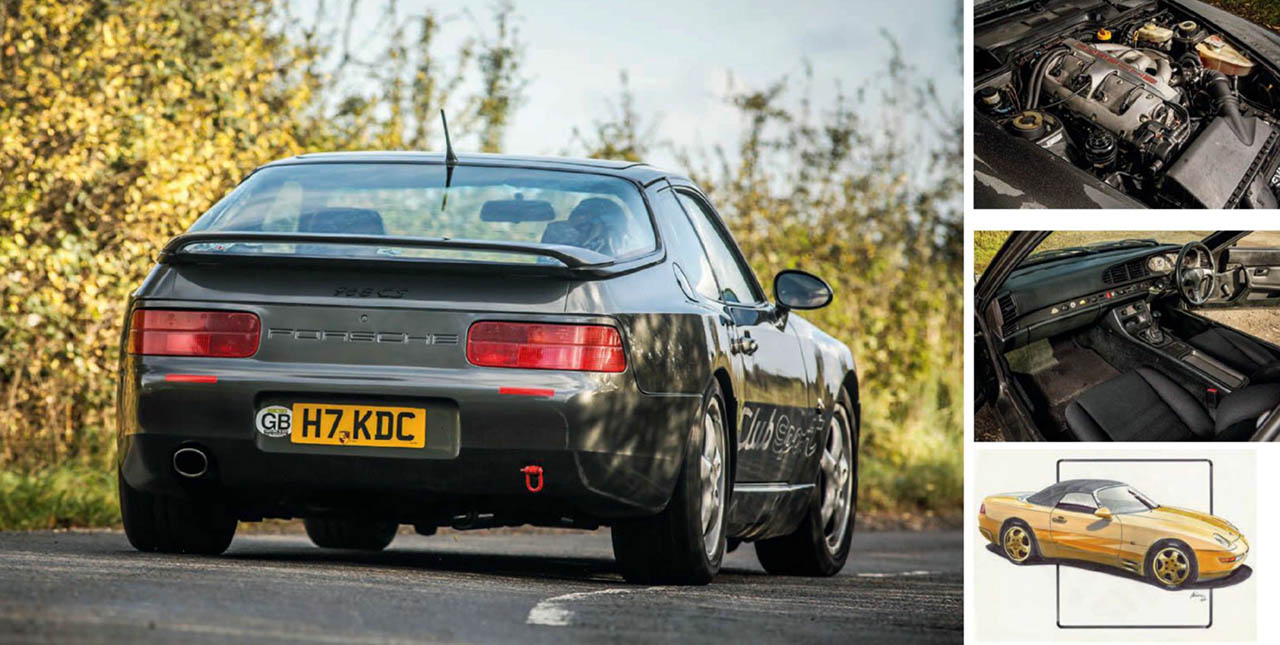
On twisty B-roads, the 968 is fabulously rewarding. Above: Speedster variant never made production.
“I left Porsche in 1977 but returned in ’89,” says Lagaay. “The 944 had been selling very well, but then it had begun to tail off. The shape had been around for a long time – perhaps too long – so my first task was to redesign it to become the 968. We had a small budget and little time, but I am particularly pleased with the result. It gave the four-cylinder car a visual link to the 928 and 964 that had been missing before.”
Here, at last, was a model that looked like a Porsche, went like a Porsche and, lest anyone was left in any doubt, was also built by Porsche in its Zuffenhausen factory. Reputedly, just 20% of the new car was carried over from the 944, and the more you look at it, the fewer similarities you find. There would be no VW parts-bin stigma attached to this car.
Beneath the reprofiled nose, the 3-litre ‘four’ from the last-of-the- line 944 was updated with Vario-Cam variable valve timing, giving a useful boost to both power and torque. Considering the motor’s tyre-shredding twist, it’s something of a paradox that a six-speed gearbox was fitted as standard – this is a car in which you can be awfully lazy with your cog-swapping. But then, as Porsche engineer Paul Hensler once pointed out, Stuttgart’s customers are people who like changing gear.
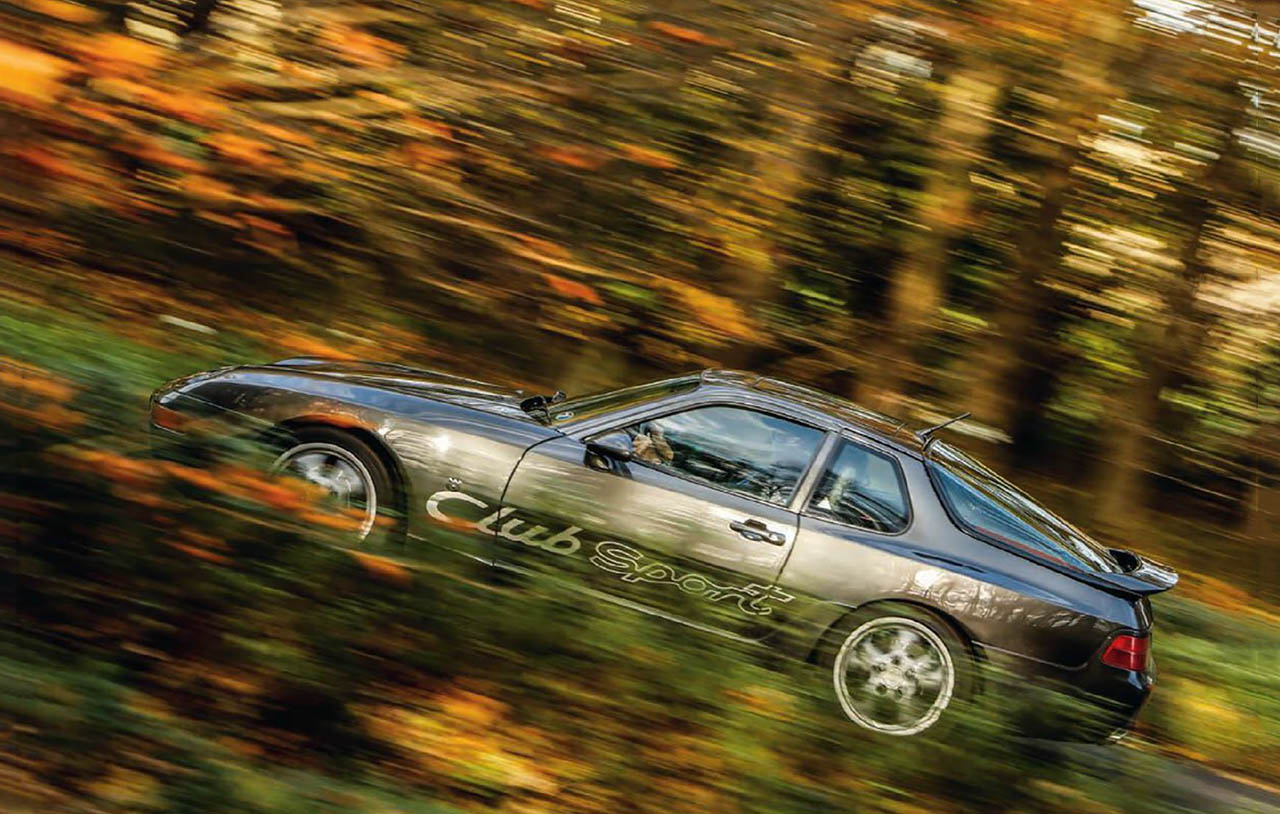
Clockwise, from main: even in Club Sport spec, the profile harks back to the first 924; 3-litre engine gives impressive performance; interior layout is largely carried over from the 944.
They are also people who like to press on, and with 240bhp plus 225lb ft of torque at its disposal, the 968 is certainly rapid. Yet in its road test, Autocar was not entirely convinced, one of the biggest criticisms being that, alongside increasingly competent Japanese models, the car was fiercely expensive. A recurring theme of these four-cylinder Porsches, it would seem. In 1993, a stripped-out special – the Club Sport – addressed that particular gripe, its lack of embellishment stripping pounds from the list price as well as from the kerb weight. Today, it is the most sought-after of the 968 range, and when you drive one it’s easy to understand why.
Compared to its forebears, the way the Club Sport handles is a revelation. On twisty back roads it is wonderfully rapid, but with never so much as a suggestion that it might bite back. Owner Ken Coad agrees. Prior to the 968, he had a 911 Carrera 2.7 and then a 993 Carrera 4, but prefers the front-engined car, its performance being far more accessible and communicative. The chassis is beautifully balanced, constantly urging you to press on faster, the steering is nicely weighted, the poise through corners totally inspiring and the engine intoxicating with its formidable punch.
The difference between the 944 and 968 is less pronounced than that between the 924 and 944, but as the ultimate incarnation of this trio, the 968 is the most accomplished. It is a wonderful plaything, yet – in spite of its stripped-for-speed spec – it is also comfortable, civilised and, I strongly suspect, a majestic long-haul tourer.
For all its dynamic qualities, though, I struggle to warm to the 968’s styling. Say what you will about the 924, the shape is one thing you can’t criticise. As time goes by, it just gets better and in today’s world of supersized sports-coupés it looks refreshingly lithe with its skinny hips and narrow wheels. It’s difficult to ignore the vastly superior powerplant of the 944, but my inner aesthete says that an early 924 is the one I’d keep. Ironically, given that they were condemned for being too pricey when new, they all now offer amazing value. To some, they may lack the cachet of a flat-six, but that just means a bargain for the rest of us. Buy now, before it’s too late.
Thanks to James Garrard, Shaun Greenham, Ken Coad; The Independent Porsche Enthusiasts Club (www.tipec.net); Porsche Club GB (www.porscheclubgb.com)
Specialist’s view
“Values have more than doubled in the past two years,” says Jon Mitchell of JMG Porsche (01202 488800). “The 944 turbo was the first to pick up and is now £15-25,000, but the 968 Club Sport (£20-30,000) and 924 Carrera GT (£40-60,000) are increasingly in demand. The 924 turbo (£5-12,000) is very rare, so that’s potentially a good investment.
“Porsches wear mileages well, so a car with 300,000 miles can drive as nicely as one with 30,000; anything with less than 100,000 should be seen as really low-mileage. Originality and service history are important. Ensure that the cam- and balance-shaft belts are changed every four years, and every eight years the water pump, front engine oil seals and belt tensioner rollers are renewed [which will cost c£1800]. Clutches can be expensive to change and typically last 45,000 miles.
“The history should show that the car has been serviced every year, regardless of miles, and turbos should be serviced twice yearly. Because they were galvanised, the post-1980 models have only recently started suffering from corrosion, usually in the rear inner and outer sills – correctly replaced sills should be seen as a definite plus point.
“As a daily driver I’d recommend the torquey 944 S2 or 968 (£10-15k), while the 924, 924 S or 944 Lux (£5-10k) are an ideal entry into classic motoring and have low running costs compared to turbos and 16-valve models. Above all, avoid project cars, because nothing is as expensive as a cheap Porsche!”
‘AS THE ULTIMATE INCARNATION OF THE BREED, THE 968 IS THE MOST ACCOMPLISHED’
TECH DATA PORSCHE 968
Sold/number built 1992-’1995/11,242 (all)
Construction galvanised steel monocoque Engine all-alloy, twin-overhead-cam, 16-valve 2990cc ‘four’, VarioCam valve timing, Bosch fuel injection.
Max power 240bhp @ 6200rpm
Max torque 225lb ft @ 4100rpm
Transmission six-speed manual or fourspeed
Tiptronic semi-automatic, RWD
Suspension independent, at front by MacPherson struts, alloy wishbones rear transverse torsion bars; dual-tube dampers, anti-roll bar f/r
Steering rack and pinion
Brakes ventilated discs f/r
Length 14ft 2in (4320mm)
Width 5ft 8in (1735mm)
Height 4ft 1in (1255mm)
Weight 2910lb (1320kg)
0-60mph 6.5 secs
Top speed 157mph
Mpg 30
Price new £28,750 (Club Sport, 1993)
TECH DATA PORSCHE 944
Sold/number built 1982-’1991/140,286 (all)
Construction galvanised steel monocoque
Engine all-alloy, sohc 2479cc ‘four’, Bosch L-Jetronic fuel injection
Max power 163bhp @ 5800rpm
Max torque 151lb ft @ 3000rpm
Transmission five-speed manual, RWD
Suspension independent, at front by
MacPherson struts, lower wishbones rear semi-trailing arms, torsion bars; telescopic dampers, anti-roll bar f/r
Steering rack and pinion
Brakes discs f/r
Length 13ft 9in (4200mm)
Width 5ft 8in (1735mm)
Height 4ft 2in (1275mm)
Weight 2632lb (1195kg)
0-60mph 7.4 secs
Top speed 137mph
Mpg 29
Price new £12 999 (1982)
Variations on a transaxle theme
924 1975-’85 2-litre VW-Audi engine; 125bhp
924 turbo 1979-’82 Cross-spoke alloys and cooling ducts in nose; 170bhp (177bhp ’81-on)
924 Carrera GT 1981 Aggressively styled 210bhp homologation special; only 406 built
924 S 1986-’88 2.5-litre 944 powerplant and running gear, plus Teledial alloy wheels
944 1981-’89 Porsche-designed 8-valve 2.5-litre ‘four’ and wide body. Bigger-bore 2.7-litre motor and 165bhp for ’89
944 turbo 1985-’91 220bhp plus restyled nose and new rear valance. Power raised to 250bhp for 1988-onwards turbo S
944 S 1987-’88 16-valve cylinder head boosts power to 190bhp @ 6000rpm
944 S2 1989-’91 Increased bore and stroke give 211bhp and 207lb ft from 3-litre 16-valve powerplant; turbo-style nose
944 S2 Cabriolet 1989-’91 Drop-top S2 by American Sunroof Company (above left). Also with 3-litre turbo in ’91 – only 528 built
968 1992-’95 Restyled body; 3-litre, 16-valve engine with variable valve timing; six-speed manual or four-speed Tiptronic semi-auto
968 Cabriolet 1992-’95
968 Club Sport 1993-’95 Less weight, uprated suspension
968 turbo S 1993-’95 Ultra-rare 8-valve, 174mph turbo variant based on Club Sport; 305bhp and 369lb ft; 14 built
Stuttgart’s other Le Mans racers
Porsche and the famous 24 Hours are inextricably linked, and a trio of factoryentered Carrera GTPs (left) – representing Germany, Great Britain and the USA – shone remarkably brightly in 1980. The entry was intended to be a low-key exercise and, with only 320bhp, the cars struggled in qualifying, but wet conditions during the race levelled the playing field considerably. The German crew of Jürgen Barth and Manfred Schurti came home an impressive sixth overall.
“We could have finished fourth,” recalls Tony Dron, who was partnered with Andy Rouse in the British car, “but a burnt-out exhaust valve meant we were on three cylinders for the last six hours. In spite of that, the car was still good for 180mph on the Mulsanne.”
The following year, the factory was back with another Carrera GTP, this time fitted with the still-secret 944 engine and an experimental 16-valve cylinder head. Producing 410bhp, it finished seventh overall in the hands of Barth and Walter Röhrl, as well as taking home a trophy for winning its class.
Ironically, although it was the fastest and most highly developed member of Porsche’s transaxle family, the 968 was never entered by the factory at La Sarthe. Thomas Bscher, Lindsay Owen-Jones and John Nielsen did share a privately entered 968 turbo RS in 1994, but, unfortunately, the car was forced to retire after an accident on lap 84.
“I WAS A SELF-TAUGHT 27 YEAR OLD, AND THE 924 WAS MY FIRST COMPLETE CAR DESIGN”
TECH DATA PORSCHE 924
Sold/number built 1976-’88/150,617 (all)
Construction steel monocoque, galvanized floorpan (fully galvanised from 1985)
Engine iron-block, alloy-head, overhead-cam 1984cc in-line ‘four’, Bosch K-Jetronic injection
Max power 125bhp @ 5800rpm
Max torque 122lb ft @ 3500rpm
Transmission four- or five-speed manual, or three-speed automatic, RWD
Suspension independent, at front by MacPherson struts, lower wishbones, anti-roll bar rear semi-trailing arms, transverse torsion bars; hydraulic dampers f/r
Steering rack and pinion
Brakes discs front, drums rear
Length 13ft 10in (4212mm)
Width 5ft 6in (1685mm)
Height 4ft 2in (1270mm)
Weight 2491lb (1130kg)
0-60mph 9.6 secs
Top speed 125mph
Mpg 25
Price new £6999
{CONTENTPOLL [“id”: 55]}





